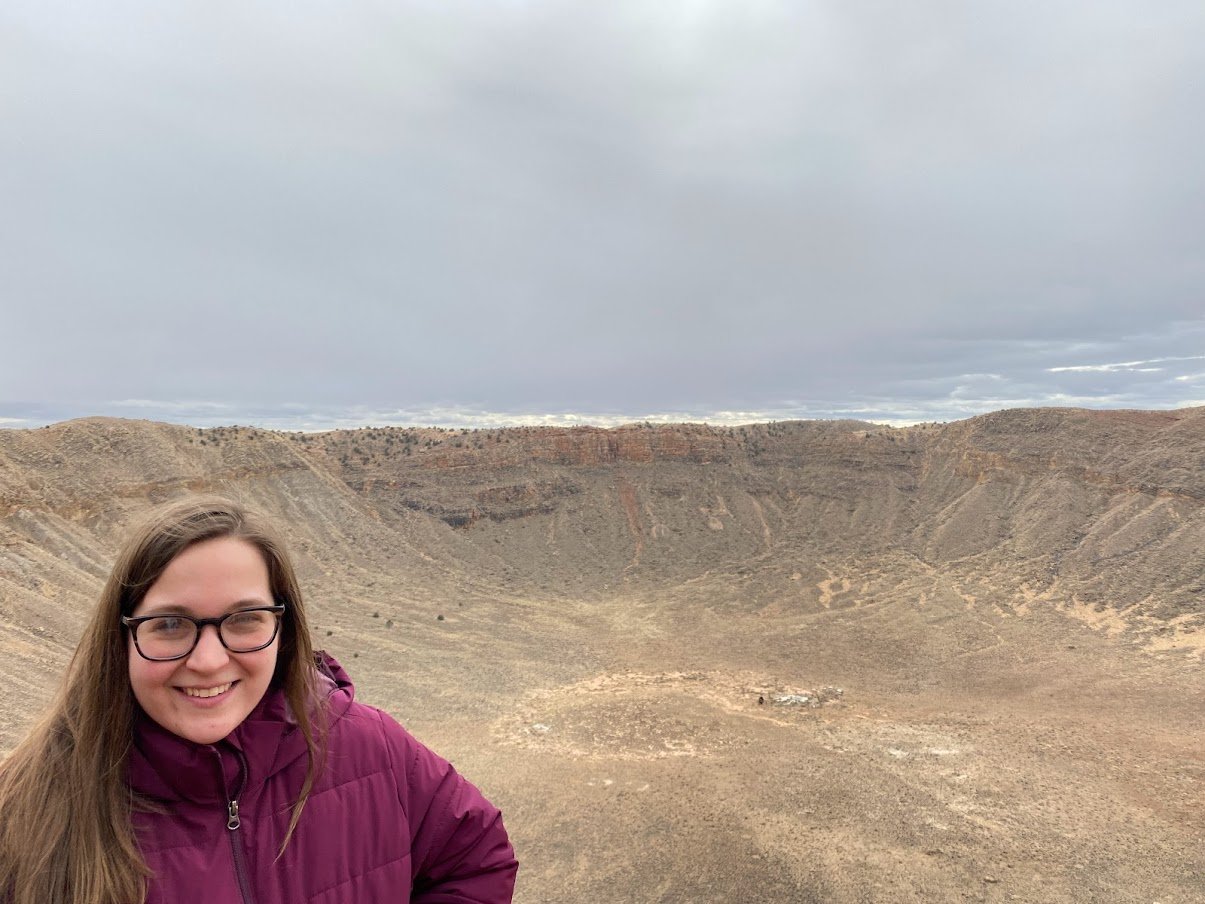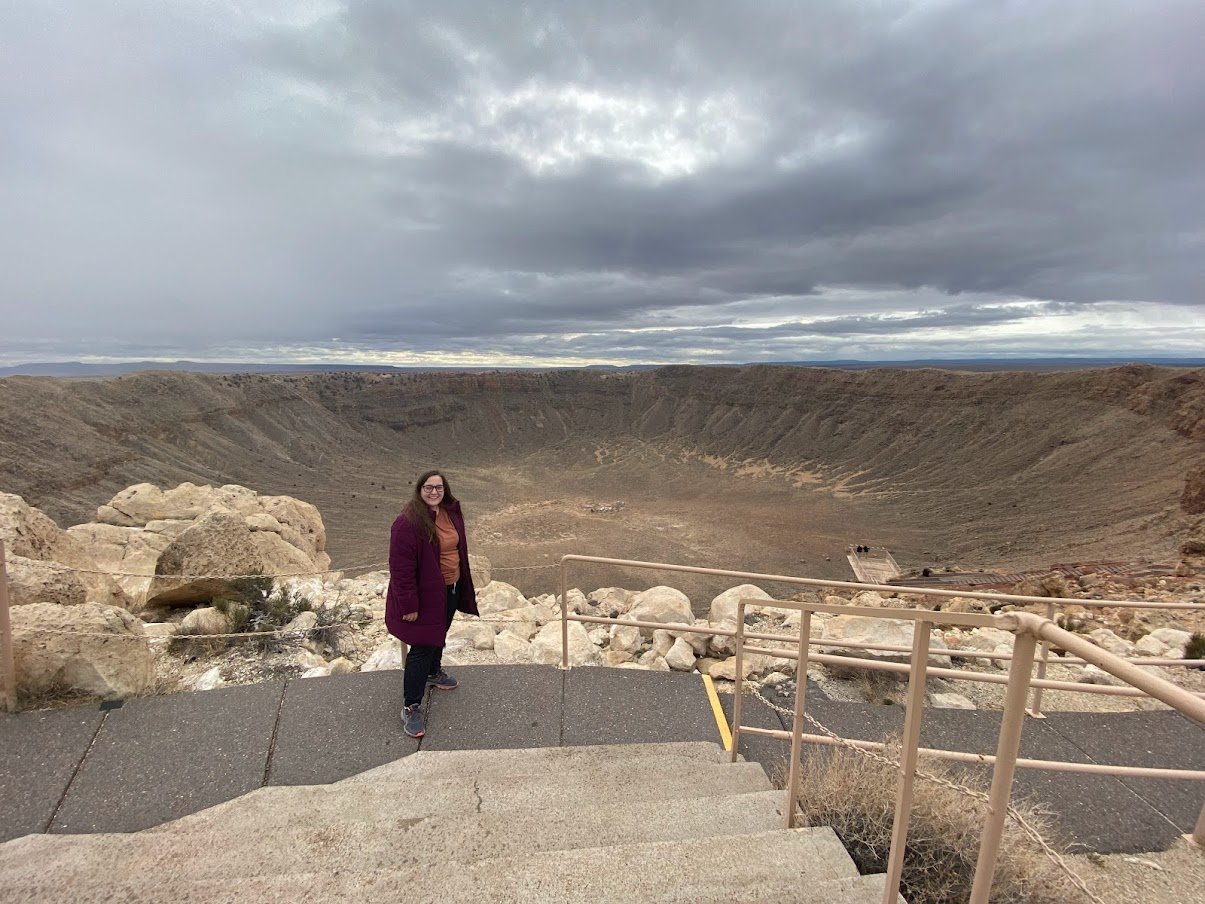Meteor Crater, Arizona
Panoramic view of Meteor Crater, Arizona.
This story is part six of my January 2022 road trip to Las Vegas. Read about our others stops here:
Charity and I left Las Vegas far later than we expected to. We knew to expect a morning session at her Get Your Teach On Conference, but that “morning” session lasted till 4:00 p.m., putting us way behind the eight ball on making it back in time for school on Wednesday. She had already taken Tuesday off for travel, but we soon realized we would need an extra day. We learned on the way to Vegas that we had also severely underestimated how much time we would lose making food, gas, and bathroom stops.
We didn’t reach Flagstaff till 10:46 p.m. and we were far too tired to make it to the next city with available hotel rooms. With a 14-hour drive ahead of us (not including stops) we knew there was no way we would make it to Tulsa in time for her to be at school on Wednesday. We would’ve arrived at the house hours after midnight and nobody wants a half-dead teacher.
She had to put in for a substitute teacher in the midst of a substitute teacher shortage, which of course stressed her out, but it ended up being a blessing in disguise. With no pressure to drive through the night, we knew we could afford a couple of unplanned stops along the way home so long as we kept them short.
The first stop we made was at Two Guns, where we had already stopped once on our way to Vegas. Seeing it in the daylight was a great experience, but we still missed out on a few buildings so we’ll have to come by again some day.
Next up was Meteor Crater, Arizona.
Barringer Crater
Approximately 50,000 years ago, a nickel-iron meteorite around 160 feet across collided with the future state of Arizona at nearly 30,000 MPH with the force of a 10-megaton bomb.
Today, the crater is nearly 600 feet deep, and that’s after millennia of erosion have removed more than fifty feet from the rim and filled in the crater with more than 100 feet of post-impact sedimentation. The bedrock of the impact is more than 700 feet below the surface, which immediately filled in with impact rubble.
The diameter of the crater is more than 7/10 of a mile with a 2.4 mile circumference.
I didn’t realize till after our trip was finished that all of our selfies looked the exact same, but I guess there’s only so many ways two people can pose.
When American settlers began encountering it in the 19th century, it soon drew the attention of Daniel Barringer. In 1903 he staked a mining claim on the crater, which by then had been ruled the result of a volcanic steam explosion by the U.S. Geological Survey.
Despite the Geological Survey’s findings, Barringer was confident it was a meteorite crater, and his assertion that there could be a massive iron deposit there convinced President Teddy Roosevelt to sign off on the claim.
Barringer had previously struck it rich on the Commonwealth silver mine in Pearce, Arizona, and he took a huge risk of failure when he began excavating the site. Barringer believed there was a 100-million-ton iron meteorite there that would have made him a billionaire by today’s standards.
At the time, little was known about meteor impact theory, and Barringer spent years drilling into the crater to look for the meteorite with no clue that almost all of it had been vaporized on contact. One chunk broke off and fell separately, however, and that piece was recovered and is on display at the Meteor Crater & Barringer Space Museum.
Although Barringer’s bet never paid off in the way he expected, he did set his family up with generational income through one of the most unique privately owned natural landmarks in the world.
The Barringer family continues to own and operate the crater, museum, and surrounding lands to this day.
Meteor Crater Space Museum
The only way to access the Barringer Crater is through the museum. There’s no free option to walk up and view it, which rubs some people the wrong way. Not me though. The museum and the grounds are privately funded and maintained. If people knew how much they’re spending on publicly funded museums and parks that they still have to pay for admission to, they’d be a lot more grateful for folks like the Barringer family.
You can view the meteor crater through several lookout points and observation decks. There are also guided rim tours included with admission, but we missed out due to precipitation.
As an elementary school teacher, I can always count on Charity to talk about how much she wishes she could bring her kids to cool sites like this.
There are a lot of free tourist destinations in the world. This unbelievably beautiful and fascinating sight costs $22 per adult, $20 for seniors 60+, and $13 for ages 6-12. I promise you it’s worth it just to view such an incredible phenomenon, especially when you consider the museum and the fact that you’re supporting a family-owned business.
The museum includes a gift shop with lots of sweet souvenirs, toys, and minerals. There are also countless exhibits about the history of the meteor crater, similar impact sites around the world, the history of space exploration, and more. You can even see a display of meteors, asteroids, and comets that are currently on paths to cross close to Earth in the future.
One of the coolest exhibits was the Collision! 4D Theater, which features a fun interactive short film about a team of astronauts breaking up a meteor before it can collide with Earth. The combination live-action and animated film stars a squirrel that’s sure to show your kids a great time, but it was really fun for adults as well.
There’s also an Apollo space capsule on the site that was used for training astronauts Buzz Aldrin, Neil Armstrong, and Michael Collins right there at Meteor Crater in the 1960s.
All in all, Meteor Crater is a must-see Arizona tourism destination that’s absolutely worth every penny. I definitely look forward to visiting again one day when I have kids!










